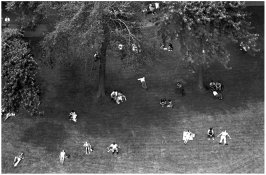In "urban landscape" IMO people is sometimes a necessary ingredient that must be present but must not draw attention to it, like salt or pepper in a course so to speak.
Imagine a façade of a church. Now imagine the same façade, with two persons seen from back while entering the church. The two persons will be "small", will not detract the general attention and meaning of the photo from the façade, but will make "more sense" of that picture, a picture of a place where people go to pray not just a piece of architecture.
Or, to make another example, imagine a city park with lake and boats on this lake with people rowing in them.
Provided the people is relatively "small" in the economy of the picture, that they are not dressed in a way which would catch too much attention, and that they are not behaving in a way that would catch the viewer's attention (a raised arm, or maybe while being bent for collecting something on the ground, etc.) they could be just the "cheese on the macaroni", the right touch to make the picture better because the absence of people would not convey the natural atmosphere of the church, public garden etc., could actually give a sense of emptiness, somehow of sadness.
Actually if one has to draw a line between "urban landscape" and "architecture" I would say it's the presence of people, which moves the attention from the "design" of the building, square, fountain, park etc. to the "function" and "life" of said building, square, fountain, park etc.
Fabrizio


